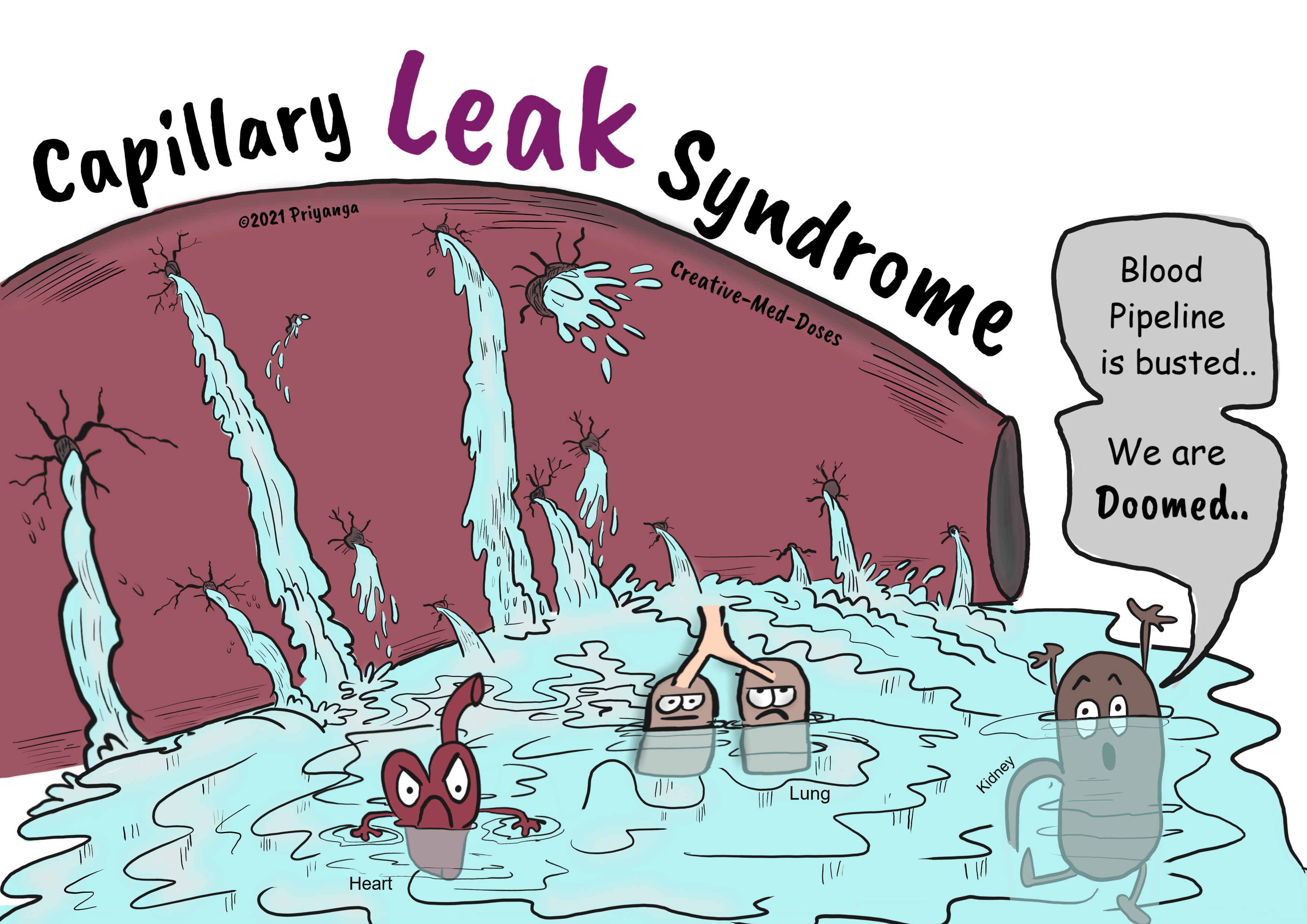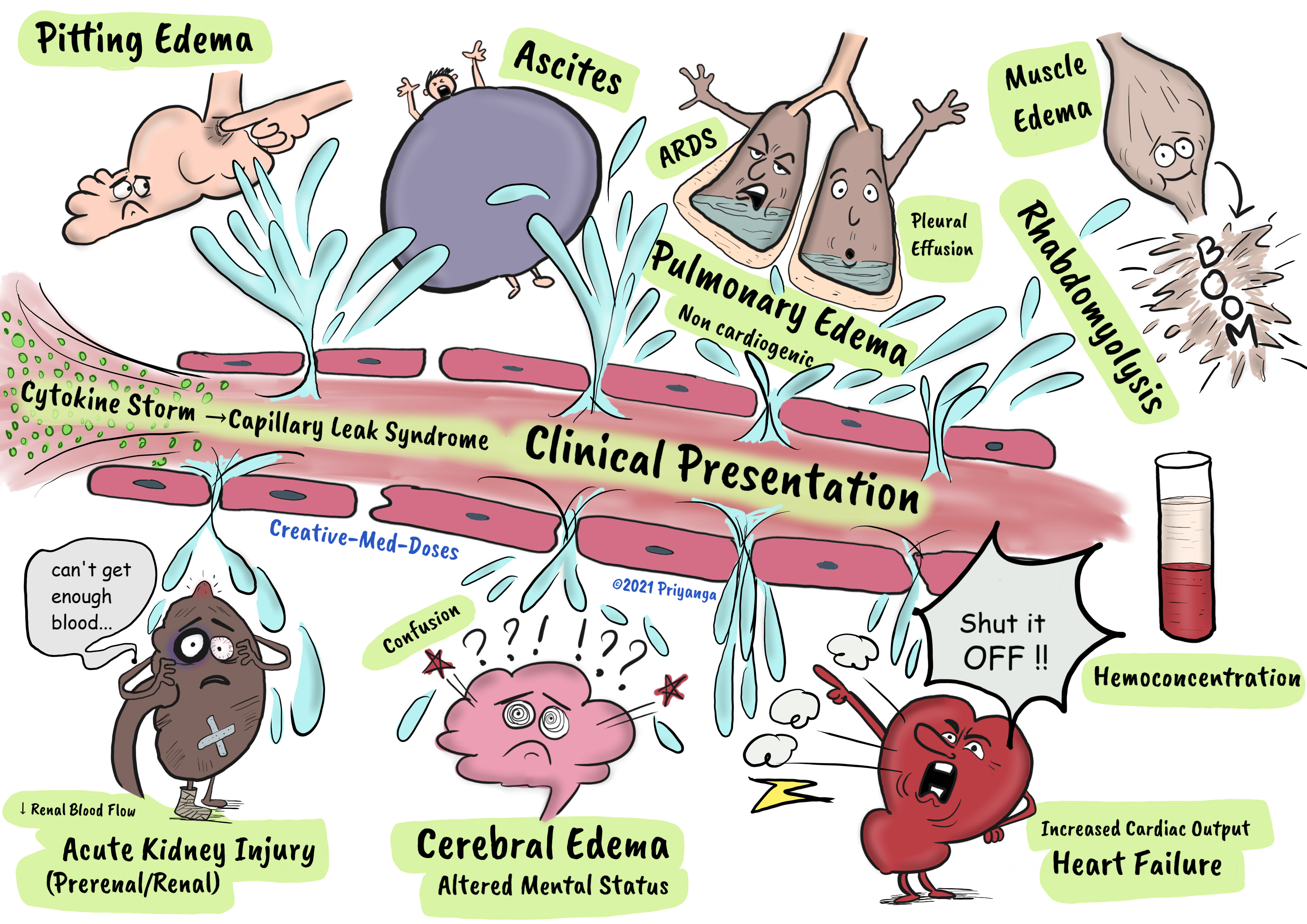Capillary Leak Syndrome (CLS): Quick Review
Capillary Leak Syndrome is associated with an increased capillary permeability to proteins. It leads to the loss of protein-rich fluid from the intravascular space to the interstitial space.
Capillary leak syndrome is characterized by
- diffuse pitting edema,
- exudative serous cavity effusions,
- noncardiogenic pulmonary edema,
- hypotension
- hypovolemic shock with multiple-organ failure (in severe cases)
...

...
Following conditions can lead to increased capillary permeability and CLS-
- Sepsis (most associated) Idiopathic systemic capillary leak syndrome (SCLS) or Clarkson’s disease
- Engraftment syndrome
- Differentiation syndrome
- Ovarian hyperstimulation syndrome (OHSS)
- Hemophagocytic lymphohistiocytosis (HLH)
- Viral hemorrhagic fevers (VHFs)
- Autoimmune diseases
- Snakebite envenomation
- Ricin poisoning
- Drugs (monoclonal antibodies e.g. rituximab)
Pathophysiology
Most diseases causing CLS have a similar underlying pathophysiologic abnormality—an increased capillary permeability to proteins.
Hypercytokinemia → Adherens junction and tight junction disruption → capillary endothelial damage and disruption → capillary become permeable for proteins→ loss of protein-rich fluid→ reduced intravascular volume and increased interstitial fluid → sign and symptoms of capillary leak syndrome.
...

...
Clinical Presentation
Hemodynamic manifestations
Capillary leak → Loss of protein-rich fluid from the intravascular space→ intravascular volume depletion → secondary activation of the renin, angiotensin, and aldosterone system →sodium and water retention → systemic edema and exudative serous cavity effusions and ascites.
Loss of intravascular volume can cause hemoconcentration in severe cases. And abrupt and significant fluid loss through the intravascular compartment. The hemoconcentration can be used as an indicator of capillary leak severity.
It can lead to hypovolemic shock and acute kidney injury in severe cases.
Pulmonary manifestations
- Pleural effusions
- Noncardiogenic pulmonary edema
- Acute respiratory distress syndrome
- Dyspnea and mild hypoxia due to the presence of large-volume ascites that restricts diaphragmatic movement.
Renal manifestations
Acute Kidney Injury is commonly seen in capillary leak syndrome cases.
Following may contribute to pathogenesis -
- Cytokine storm and Tubular necrosis
- Reduced renal blood flow because of reduced intravascular volume
- Acute tubular necrosis
- Rhabdomyolysis and myoglobinuria following muscle edema can also damage kidney
Other manifestations
- Ascites
- Rhabdomyolysis and compartment syndrome due to muscle
- Intestinal edema
- Abdominal pain, nausea, and vomiting
...

...
Management
Fluid resuscitation: it has a central role in CLS management
Fluid resuscitation increases the intravascular volume and thus improves blood pressure and renal function. But Fluid resuscitation also expands the interstitial volume and potentially worsens systemic edema, increases effusions, and worsens pulmonary, intestinal, and muscle edema. It is a double-edged sword and must be used judiciously.
In cases where fluid overload symptoms predominate, and Blood Pressure is stable -
- Loop Diuretics is given to reduce edema and effusions
- Adding 25% albumin i.v. may facilitate volume removal
- Cases with AKI refractory to diuretics will require renal replacement (dialysis)
Revision for today Neuropathic arthropathy: Charcot arthropathy - Creative Med Doses
Buy fun review books here (these are kindle eBook’s you can download kindle on any digital device and login with Amazon accounts to read them). Have fun and please leave review.
https://creativemeddoses.com/books/